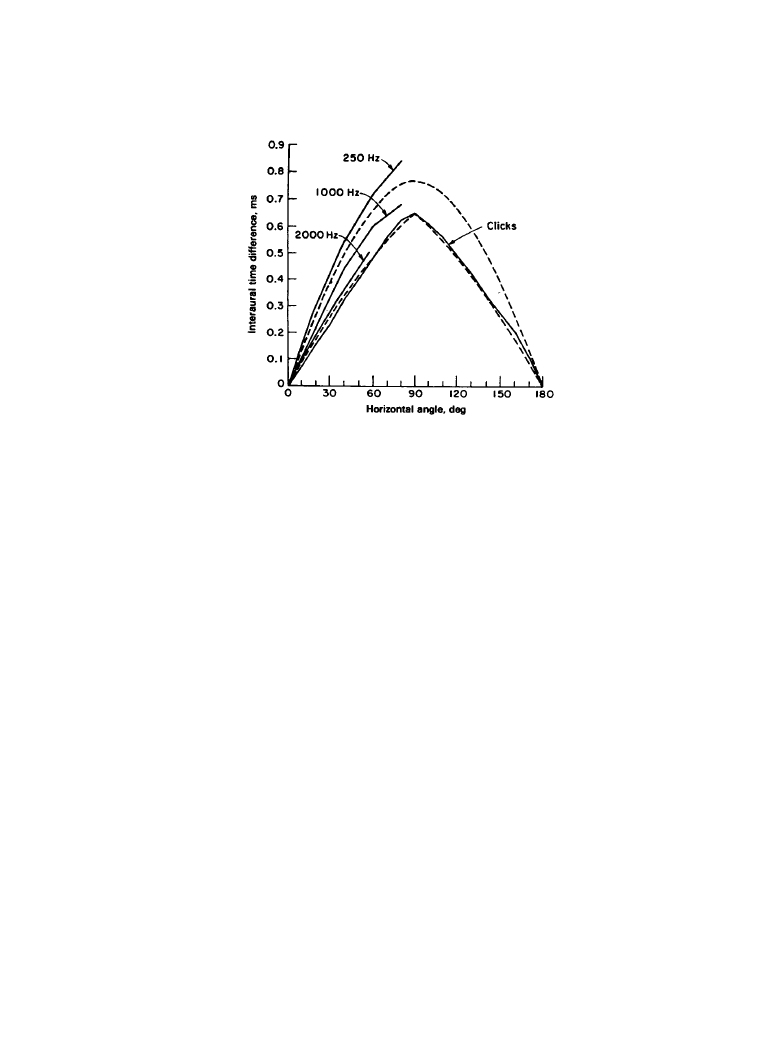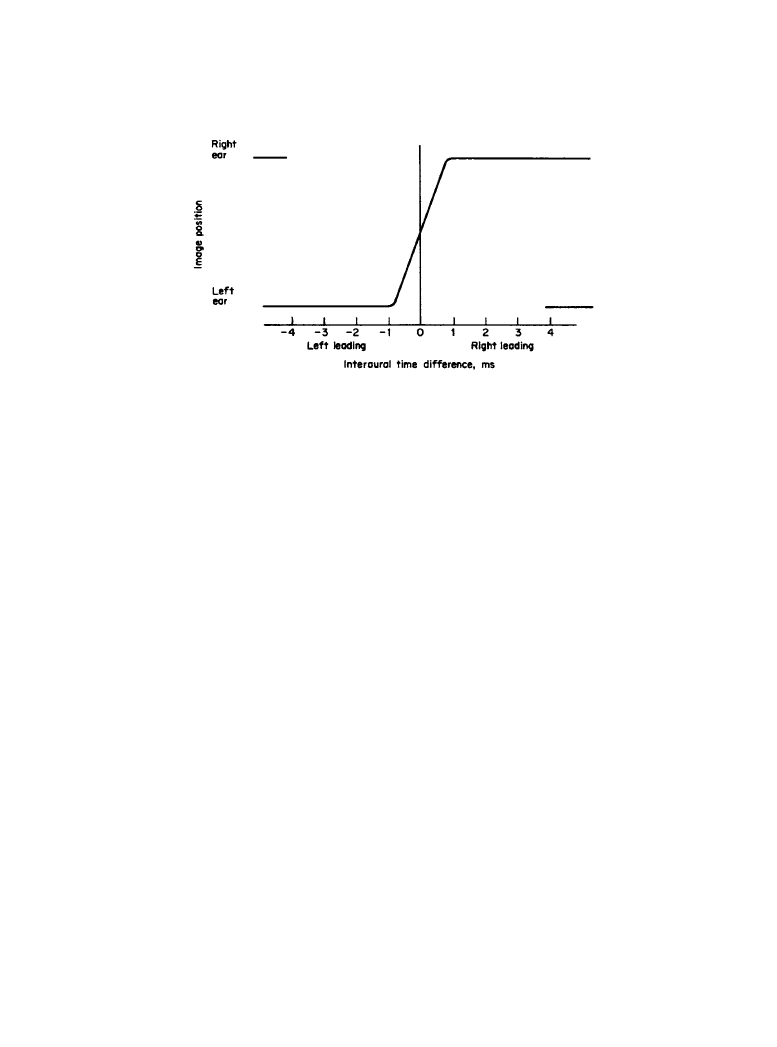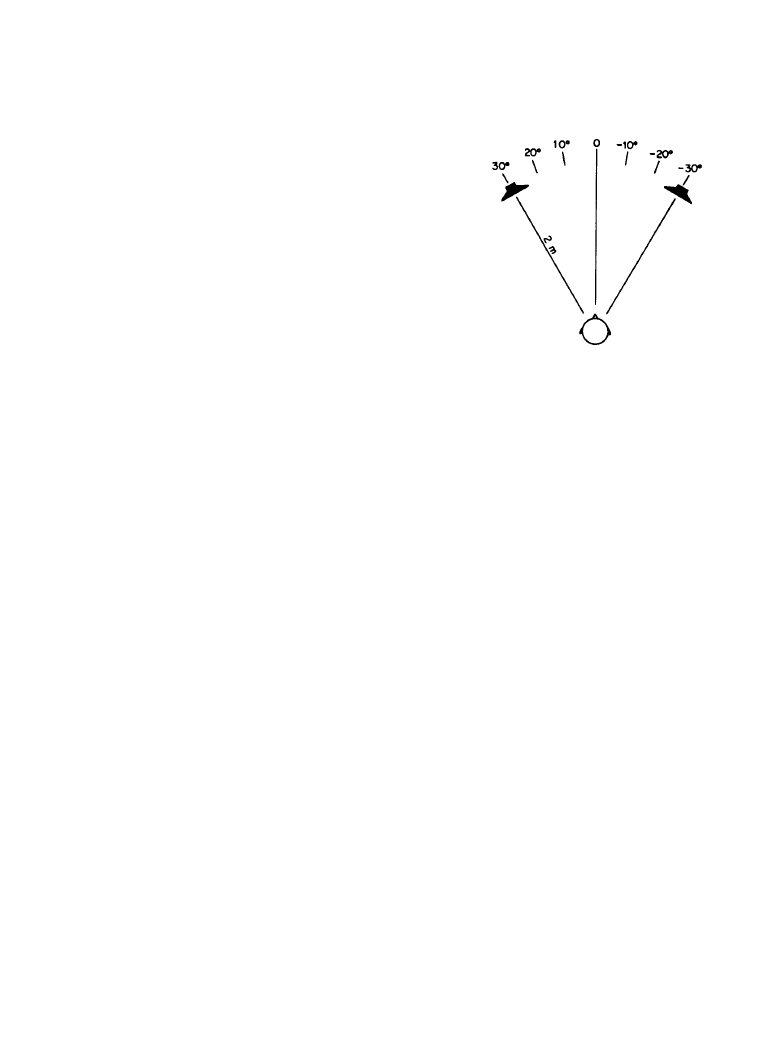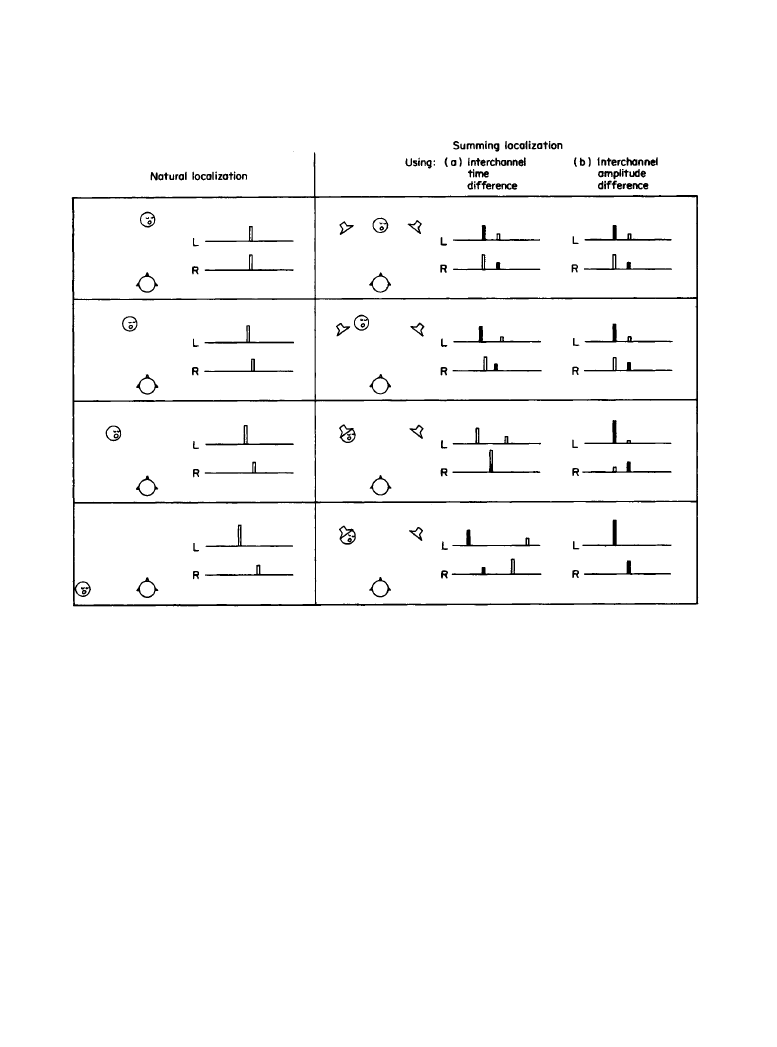ВУЗ: Казахская Национальная Академия Искусств им. Т. Жургенова
Категория: Книга
Дисциплина: Не указана
Добавлен: 03.02.2019
Просмотров: 21581
Скачиваний: 19

The Physical Nature of Hearing 1-61
quency-independent variations of these parameters are therefore unlikely to achieve the image
size and positional precision associated with natural sound events.
Localization Blur
In normal hearing the precision with which we are able to identify the direction of sounds
depends on a number of factors. The measure of this precision is called localization blur, the
smallest displacement of the sound event that produces a just-noticeable difference in the corre-
sponding auditory event. The concept of localization blur characterizes the fact that auditory
space (the perception) is less precisely resolved than physical space and the measures we have of
it.
The most precise localization is in the horizontal forward direction with broadband sounds
preferably having some impulsive content. The lower limit of localization blur appears to be
about 1°, with typical values ranging from 1 to 3°, though for some types of sound values of 10°
or more are possible. Moving away from the forward axis, localization blur increases, with typi-
cal values for sources on either side of the head and to the rear being around 10 to 20°. Vertically,
localization blur is generally rather large, ranging from about 5 to 20° in the forward direction to
30 to 40° behind and overhead [17].
Lateralization versus Localization
In exploring the various ways listeners react to interaural signal differences, it is natural that
headphones be used, since the sounds presented to the two ears can then be independently con-
Figure 1.4.9
Interaural time difference as a function of horizontal angle. The curves show mea-
sured data for clicks and pure tones (solid lines) and predictive curves for low frequencies (top
dashed curve), based on diffraction theory, and for high frequencies (bottom dashed curve), based
on creeping-wave concepts. (
From [41]. Used with permission.)
Downloaded from Digital Engineering Library @ McGraw-Hill (www.digitalengineeringlibrary.com)
Copyright © 2004 The McGraw-Hill Companies. All rights reserved.
Any use is subject to the Terms of Use as given at the website.
The Physical Nature of Hearing

1-62 Principles of Sound and Hearing
trolled. The auditory events that result from this process are distinctive, however, in that the per-
ceived images occur inside or very close to the head and image movement is predominantly
lateral. Hence, this phenomenon has come to be known as lateralization, as opposed to localiza-
tion, which refers to auditory events perceived to be external and at a distance. Overcoming the
in-head localization characteristic of headphone listening has been a major difficulty, inhibiting
the widespread use of these devices for critical listening.
In headphone listening it is possible to move the auditory event by independently varying the
interaural time or amplitude difference. Manipulating interaural time alone yields auditory image
trajectories of the kind shown in Figure 1.4.10, indicating that the ITD required to displace the
auditory image from center completely to one side is about 0.6 ms, a value that coincides with
the maximum ITD occurring in natural hearing (Figure 1.4.9). Although most listeners would
normally be aware of a single dominant auditory image even when the ITD exceeds this normal
maximum value, it is possible for there to be multiple auditory images of lesser magnitude, each
with a distinctive tonal character and each occupying a different position in perceptual space.
With complex periodic signals, experienced listeners indicate that some of these images follow
trajectories appropriate to the individual harmonics for frequencies that are below about 1 kHz
[31]. This spatial complexity would not be expected in normal listening to a simple sound
source, except when there are delayed versions of the direct sounds caused by strong reflections
or introduced electronically. The result, if there are several such delayed-sound components, is a
confused and spatially dispersed array of images, coming and going with the changing spectral
and temporal structure of the sound. It seems probable that this is the origin of the often highly
desirable sense of spaciousness in live and reproduced musical performances.
The sensitivity of the auditory system to changes in ITD in the lateralization of auditory
images, or lateralization blur is dependent on both the frequency and the amplitude of the signal.
According to various experimenters, lateralization blur varies from around 2
µs to about 60 µs,
increasing as a function of signal frequency and sound level, and is at a minimum point around
ITD = 0.
Figure 1.4.10
Perceived positions of the dominant auditory images resulting from impulsive sig-
nals (clicks) presented through headphones when the interaural time difference is varied.
Downloaded from Digital Engineering Library @ McGraw-Hill (www.digitalengineeringlibrary.com)
Copyright © 2004 The McGraw-Hill Companies. All rights reserved.
Any use is subject to the Terms of Use as given at the website.
The Physical Nature of Hearing

The Physical Nature of Hearing 1-63
Introducing an IAD displaces the auditory event toward the ear receiving the louder sound.
An IAD of between 10 and 20 dB seems to be sufficient to cause the image to be moved com-
pletely to one side. The precise figure is difficult to ascertain because of the rapid increase in lat-
eralization blur as a function of IAD; the auditory event becomes wider as it approaches the side
of the head. Close to center, however, the lateralization blur is consistently in the vicinity of 1 to
2 dB.
Spatial Impression
Accompanying the auditory impression of images in any normal environment is a clear impres-
sion of the type and size of the listening environment itself. Two aspects appear to be distinguish-
able: reverberance, associated with the temporal stretching and blurring of auditory events
caused by reverberation and late reflections; and spaciousness, often described as a spreading of
auditory events so that they occupy more space than the physical ensemble of sound sources.
Other descriptors such as ambience, width, or envelopment also apply. Spaciousness is a major
determinant of listener preference in concert halls and as such has been the subject of consider-
able study.
In general, the impression of spaciousness is closely related to a lack of correlation between
the input signals to the two ears. This appears to be most effectively generated by strong early lat-
eral reflections (those arriving within about the first 80 ms after the direct sound). While all
spectral components appear to add positively to the effect and to listener preference, they can
contribute differently. Frequencies below about 3 kHz seem to contribute mainly to a sense of
depth and envelopment, while high frequencies contribute to a broadening of the auditory event
[32].
The acoustical interaction of several time-delayed and directionally displaced sounds at the
ears results in a reduced interaural cross correlation; the sense of spaciousness is inversely pro-
portional to this correlation. In other terms, there is a spectral and temporal incoherence in the
sounds at the ears, leading to the fragmentation of auditory events as a function of both fre-
quency and time. The fragments are dispersed throughout the perceptual space, contributing to
the impression of a spatially extended auditory event.
1.4.3i
Distance Hearing
To identify the distance of a sound source listeners appear to rely on a variety of cues, depending
on the nature of the sound and the environment. In the absence of strong reflections, as a sound
source is moved farther from a listener, the sound level diminishes. It is possible to make judg-
ments of distance on this factor alone, but only for sounds that are familiar, where there is a
memory of absolute sound levels to use as a reference. With any sound, however, this cue pro-
vides a good sense of relative distance.
In an enclosed space the listener has more information to work with, because as a sound
source is moved away, there will be a change in the relationship between the direct sound and the
reflected and reverberant sounds in the room. The hearing mechanism appears to take note of the
relative strengths of the direct and indirect sounds in establishing the distance of the auditory
event. When the sound source is close, the direct sound is dominant and the auditory image is
very compact; at greater distances, the indirect sounds grow proportionately stronger until even-
tually they dominate. The size of the auditory event increases with distance, as does the localiza-
tion blur.
Downloaded from Digital Engineering Library @ McGraw-Hill (www.digitalengineeringlibrary.com)
Copyright © 2004 The McGraw-Hill Companies. All rights reserved.
Any use is subject to the Terms of Use as given at the website.
The Physical Nature of Hearing

1-64 Principles of Sound and Hearing
1.4.3j
Stereophonic Imaging
Consider the conventional stereophonic arrangement shown in Figure 1.4.11. If the two loud-
speakers are radiating coherent sounds with identical levels and timing, the listener should per-
ceive a single auditory event midway between the loudspeakers. This phantom, or virtual, sound
source is the result of summing localization, the basis for the present system of two-channel ste-
reophonic recording and reproduction.
Progressively increasing the time difference between the signals in the channels displaces the
auditory event, or image, toward the side radiating the earlier sound until, at about 1 ms, the
auditory image is coincident with the source of the earlier sound. At time differences greater
than about 1 ms the perception may become spatially more dispersed, but the principal auditory
event is generally perceived to remain at the position of the earlier sound event until, above some
rather larger time difference, there will be two auditory events occurring separately in both time
and space, the later of which is called an echo.
The region of time difference between that within which simple summing localization occurs
and that above which echoes are perceived is one of considerable interest and complexity. In this
region the position of the dominant auditory event is usually determined by the sound source that
radiates the first sound to arrive at the listener's location. However, depending on the nature of
the signal, simple summing localization can break down and there can be subsidiary auditory
images at other locations as well. The later sound arrivals also influence loudness, timbre, and
intelligibility in ways that are not always obvious.
The cause of this complexity can be seen in Figure 1.4.12, showing the sounds arriving at the
two ears when the sound is symbolically represented by a brief impulse. It is immediately clear
that the fundamental difference between the situation of summing localization and that of natural
localization is the presence of four sound components at the ears instead of just two.
In all cases the listener responds to identical ear input signals by indicating a single auditory
event in the forward direction. Note, however, that in both stereo situations the signals at the two
ears are not the same as the signals in normal localization. Thus, even though the spatial aspects
have been simulated in stereo, the sounds at the two ears are modified by the acoustical crosstalk
from each speaker to the opposite ear, meaning that perfectly accurate timbral reproduction for
these sounds is not possible. This aspect of stereo persists through all conditions for time-differ-
ence manipulation of the auditory image, but with amplitude-difference manipulation the effect
Figure 1.4.11
Standard stereophonic listening configura-
tion.
Downloaded from Digital Engineering Library @ McGraw-Hill (www.digitalengineeringlibrary.com)
Copyright © 2004 The McGraw-Hill Companies. All rights reserved.
Any use is subject to the Terms of Use as given at the website.
The Physical Nature of Hearing

The Physical Nature of Hearing 1-65
diminishes with increasing amplitude difference until, in the extreme, the listener hears only
sound from a single speaker, a monophonic presentation.
Although impressions of image movement between the loudspeakers can be convincingly
demonstrated by using either interchannel time or amplitude differences, there is an inherent lim-
itation in the amount of movement: in both cases the lateral displacement of the principal audi-
tory event is bounded by the loudspeakers themselves.
With time differences, temporal masking inhibits the contributions of the later arrivals, and
the localization is dominated by the first sound to arrive at each ear. With small time differences
the image can be moved between the loudspeakers, the first arrivals are from different loud-
Figure 1.4.12
Comparison between sound localization in natural listening and localization in ste-
reophonic listening within the range of simple summing. For the purposes of this simplified illustra-
tion, the sound waveform is an impulse. To the right of the pictoral diagrams showing a listener
receiving sound from either a single source (natural localization) or a stereo pair of loudspeakers
(summing localization) are shown the sounds received by the left and right ears of the listener. In
the stereo illustrations, sounds from the left loudspeaker are indicated by dark bars and sounds
from the right loudspeaker by light bars.
Downloaded from Digital Engineering Library @ McGraw-Hill (www.digitalengineeringlibrary.com)
Copyright © 2004 The McGraw-Hill Companies. All rights reserved.
Any use is subject to the Terms of Use as given at the website.
The Physical Nature of Hearing